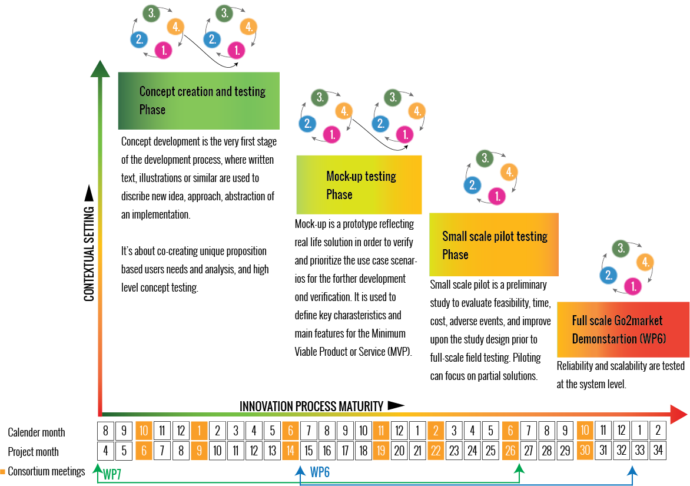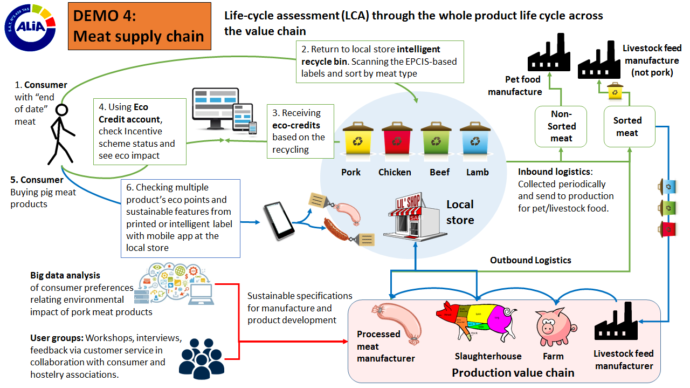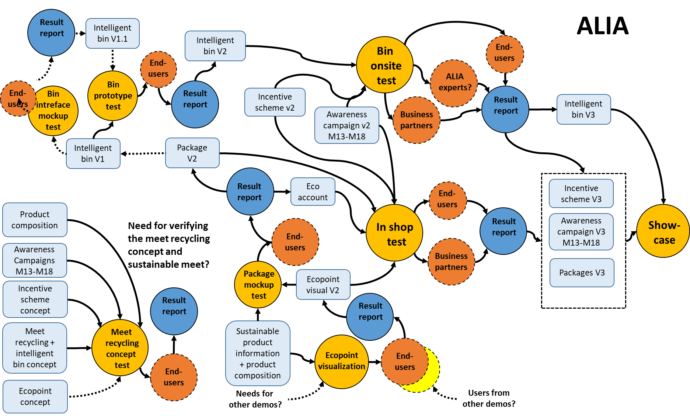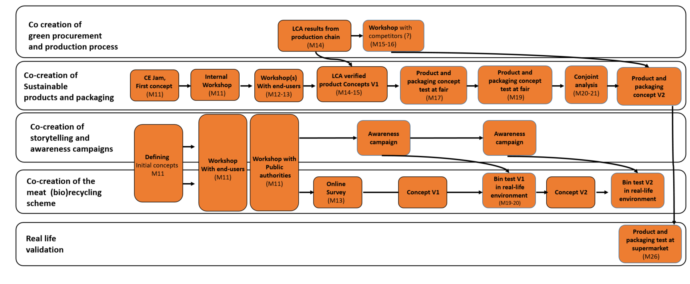Living Labs have a number of definitions and multiple implementations. For this reason implementing Living Labs in a project is often a confusing task: how does one start a Living Lab? What is the process, resources needed, and practical steps in creating a Living Lab? In this article we give an example of a practical approach to planning and implementing Living Labs.
What are Living Labs?
Living Labs have become a well-known but not well understood concept used mainly in the context of collaborative development to solve complex societal needs. The confusion can partly be explained by the fact that no universal definition of Living Labs exist. A number of researchers define Living Labs as real or virtual environments, or interaction spaces (Almirall et al. (2012) and Bergvall-Kåreborn et al. (2009)), in which stakeholders from quadruple helix collaborate for creating new solutions to complex societal problems. Similar to this, living lab are also defined as networks that integrate both user-centered research and open innovation (Leminen et al, 2012). Others (e.g. Eriksson et al, 2005) empathize Living Lab as a methodology for user engagement. The European Network of Living Labs (ENoLL) defines Living Labs as “user-centered, open innovation ecosystems based on systematic user co-creation approach, integrating research and innovation processes in real life communities and settings. They operate as intermediaries among citizens, research organisations, companies, cities and regions for joint value co-creation, rapid prototyping or validation to scale up innovation and businesses” (U4IOT, 2018, p.6). Living Labs have common elements but multiple different implementations.
Laurea approach to Living Labs
Laurea approach to Living Labs is based on ENoLL’s definition of open innovation ecosystems, in which the role of Laurea Living Lab Networks is to integrate education, R&D and regional development (Laurea 2018). Moreover, Laurea defines its Living Labs as real-life environments, both inside Laurea (such as campuses, or Bar Laurea), and outside, such as public libraries, hospitals and urban districts. Laurea positions itself as an intermediary at the regional, national and international levels by developing networks and culture of innovation, and sharing platforms, methodologies and evidence-based knowledge.
Living Labs in CIRC4Life project
CIRC4Life (A circular economy approach for lifecycles of products and services) project is a three-year project, supported by the European Commission H2020 circular economy programme, that develops new circular economy business models (CEBMs) and demonstrates them in four industrial sectors. Laurea’s role in the project is to develop a common framework and implementation plan for Living Labs, and to coordinate end-user and stakeholder involvement in the Living Lab activities. The CIRC4Life Living Lab is used both as a methodological approach towards development of CEBMs, and as a process of engaging stakeholders in a systematic way.
In CIRC4Life project, Living Labs are defined and used as a framework for involving actual customers and other key stakeholder in the collaborative innovation process. The CIRC4Life Living Lab framework is presented in Fig.1 below. We used four stages of innovation process, including the concept creation, mock-up testing, small scale pilot testing, and full scale market launch, as the basic for planning Living Labs (WP7) and Demonstration (WP6) activities within the project. We also made a separation between Living Labs and Demonstrations, to follow DoA. In practice, testing/piloting stage of Living Lab activities will be partly integrated into demonstration activities later in the project.
 Figure 1. Framework for CIRC4Life Living Labs
Figure 1. Framework for CIRC4Life Living Labs
According to developed framework, each stage of an innovation process is implemented based on iterative rounds consisting of four steps: explore, co-create, implement, and evaluate. The number and duration of the iterations varies depending on the development task. Each round lasts approximately 4 months. Consortium meetings are used as a milestone to evaluate the results of each round, and adjust Living Lab plans.
Living Lab planning phases
As the starting point for Living Lab planning, we used Open Innovation Camp (OIC), which is a “co-creation sprint type of multi-day event grounded on an open innovation 2.0 principles where a group of carefully selected stakeholders having diverse but complimentary expertise creates a common understanding of (a complex societal) challenge and work together to develop in a co-creative manner user centered concepts and solutions to pre-defined challenges in a set timeframe” (Santonen et al, 2019). OIC is also going to be used as the final stage of CIRC4Life Living Labs, as a validation tool for developed solutions.
Below is proposed timeframe for planning Living Lab activities in a 36-month project.
M0-M7: CREATING COMMON UNDERSTANDING OF LIVING LABS
· Preliminary description of the demonstration concepts,
· Definition of key open questions to be solved during the Living Labs
· Detailed planning and organisation of the 1st Innovation Camp to address open questions.
M7-M9: LL V0 – PRELIMINARY LL PLAN
· Concept refinement and modifications based on 1st Innovation Camp results
· Refinement of the key questions to be solved during the Living Lab activities
· Overall planning of the Living Lab activities
M9-M14: LL V1 – CONCEPT DEVELOPMENT
· Finalizing the overall Living Lab activity plan, which will be continuously updated after each follow-up iteration round
· Demonstration-specific Living Lab activity plans identifying the key demonstration activities and open questions that need Living Lab support
· Acquiring market and end-users needs for preliminary concepts and running limited mockup and prototype tests during the co-creation workshops
M14-M19: LL V2 – CONCEPT REFINEMENT AND SCENARIO DEVELOPMENT
· Finalizing the co-created concepts and scenarios for each demonstration based on market feedback and workshop results
· Running limited mockup and prototype tests in order to ensure easy-of-use and understandability.
M19-M22: LL V 3 – TESTING
· Validating and evaluating the co-created concepts and alternative options in real life demonstration settings
· Omitting the solutions which do have market acceptance.
M22-M26: LL V4 – EVALUATION
· Continue validating and evaluating the co-created concepts and alternative options in real life demonstration settings
· Scalability testing to ensure performance
M26-M30: LL V5 – VALIDATION
· Summarizing and reporting the co-created concepts and alternative options in real life demonstration settings
· Preparations for 2nd Innovation Camp and selecting the final showcases.
Example of Living Labs in CIRC4Life
To develop Living Lab plan, we used the following approach:
1) understand the ecosystem from a customer point of view;
2) create a blueprint of LL activities empathizing concept co-creation and solution testing;
3) define LL timeline to structure LL activities in logical sequence within the project lifespan.
When planning Living Labs, the ecosystem development (Fig.2 below) starts with the customer journey mapping, as illustrated by step 1 in the figure. The customer journey is then separated into a number of steps to reflect the process of purchasing, consumption and recycling. Along the customer journey key ecosystem stakeholders are identified, as well as ICT infrastructure and support resources. The outcome is the ecosystem visualization from a customer point of view.
 Figure 2. Ecosystem visualization
Figure 2. Ecosystem visualization
The second phase in developing Living Labs is understanding of open questions that need to be answered in order to ensure that the ecosystem is functioning well from a customer viewpoint. For each step of a customer journey a set of co-creation, concept development, and testing activities is suggested in a Living Lab blueprint, as picture in Fig. 3 below. Activities are linked to each other to show their interdependency, in order words, how results of one Living Lab activity influence the following activity. In CIRC4Life case we used color codes to separate Living Lab testing (yellow bubbles); ecosystem actors (orange); LL reports (blue) and content of each LL activity (light blue).
 Figure 3. Living Lab blueprint
Figure 3. Living Lab blueprint
As the final phase, identified Living Lab activities are clustered around stages of circular economy: production and procurement, product development, awareness and consumption, and recycling, and put to a timeline based on the project duration. In the example below in Fig.4 Living Lab activities started on M11 and continued until M26.
 Figure 4.Living Lab timeline
Figure 4.Living Lab timeline
Ecosystem-activity-process approach to Living Labs allow for understanding key stakeholders in ecosystem and their role (step1); developing a set of co-creation activities for different stages of innovation maturity (step 2), and creating realistic timeline to serve as the implementation plan for LL (step 3). Similar approach can be used in the context of projects addressing different complex societal challenges, to which solutions require collaborative efforts of diverse stakeholders.
For more information see D7.1 Living Labs Concepts and Implementation Plan for CIRC4Life-project, to be published in autumn 2019.
References:
Almirall, E., and J. Wareham. (2008): Living Labs and open innovation: roles and applicability. Electronic Journal for Virtual Organizations and Networks. 21–46.
Bergvall-Kåreborn, B. and Ståhlbröst, A. (2009) ‘Living Lab: an open and citizen-centric approach for innovation’, Int. J. Innovation and Regional Development , Vol. 1, No. 4, pp.356–370
CIRC4Life (2018). A circular economy approach for lifecycles of products and services. Retrieved from https://www.circ4life.eu/
Eriksson, M., V. P. Niitamo, and S. Kulkki. (2005). State-of-the-Art in Utilizing Living Labs Approach to User-centric ICT innovation – a European approach. CDT at Luleå University of Technology, Sweden, Nokia Oy, Centre for Knowledge and Innovation Research at Helsinki Scholl of Economics, Finland, 2005
Laurea (2018). Laurea Living Labs, Retrieved from https://www.laurea.fi/en/research/laurea-living-labs/
Leminen, S., M. Westerlund, and A-G. Nyström. 2012. Living Labs as Open-Innovation Networks. Technology Innovation Management Review. September 2012: 6-11.
Santonen, T, Nevmerzhitskaya, J, Purola, A, Haapaniemi, H. (2019) Open Innovation Camp (OIC) – a tool for solving complex problems rapidly. Paper to be presented at ENoLL Open Living Labs Day
U4IOT, (2018). User engagement for large scale pilots in the internet of things: Living Lab Methodology Handbook. Retrieved from: https://u4iot.eu/pdf/U4IoT_LivingLabMethodology_Handbook.pdf